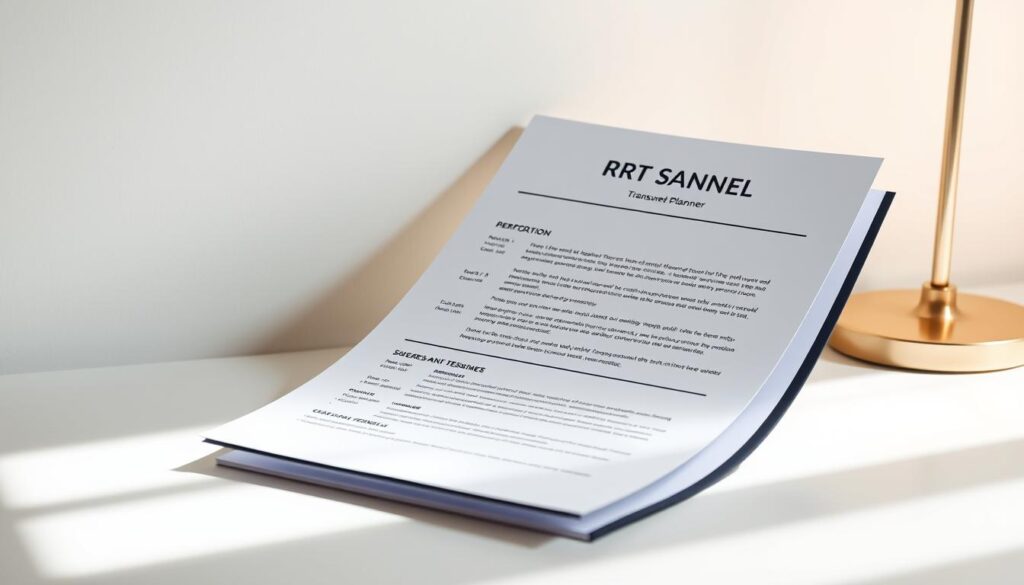Is a Master’s Degree Enough to Secure Your Future in Transportation Planning? While advanced education is critical, employers now prioritize candidates who combine technical expertise with adaptability to emerging trends. The field is evolving rapidly—with sustainability mandates, smart city initiatives, and AI-driven logistics reshaping how infrastructure projects are designed.
With a $78,500 average salary and steady 4% job growth, competition for these roles is intensifying. You’ll need more than academic credentials to stand out. This guide reveals proven tactics to refine your resume, align your skills with 2025 industry demands, and leverage tools like professional resume examples tailored for transportation roles.
RoboApply simplifies the process by automating job searches and optimizing applications for ATS systems. You’ll learn how to highlight certifications, showcase project portfolios, and answer behavioral interview questions with confidence. Let’s prepare you to not just meet expectations—but exceed them.
Key Takeaways
- Transportation planners earn $78,500 on average, with 4% growth projected through 2031.
- Technical skills like GIS software mastery are essential, but soft skills like collaboration differentiate top candidates.
- ATS-friendly resumes require keyword optimization and clear metrics for infrastructure projects.
- Behavioral interviews focus on problem-solving in real-world scenarios like traffic flow redesigns.
- RoboApply’s tools automate application tracking and provide industry-specific resume templates.
Understanding the Transportation Planner Role
Navigating the complexities of urban mobility requires more than technical know-how—it demands vision. Professionals in this field shape how communities move, balancing immediate needs with decades-long infrastructure goals.
Job Responsibilities and Daily Tasks
Your day begins with analyzing proposed transportation projects, from bike lane expansions to parking structure designs. You’ll assess environmental impacts, model traffic patterns using GIS software, and draft reports that inform critical decisions. Mathematical modeling helps predict how infrastructure changes affect congestion over 10-20 years.
Collaboration forms the backbone of your work. Expect to partner with engineers to ensure road designs meet safety standards and environmental planners to comply with sustainability laws. One transportation planner notes:
“Our solutions must satisfy commuters today while preparing for population shifts in 2040.”
Work Environments and Sectors
Most professionals (66%) work in local government offices reviewing zoning proposals or securing grants for public transit upgrades. Others thrive in engineering firms designing smart city networks or consulting agencies optimizing freight logistics. Key sectors include:
- Municipal agencies managing bus rapid transit systems
- State departments overseeing highway expansions
- Private firms creating EV charging networks
Whether advocating for pedestrian-friendly downtowns or project coordinator roles in rail development, your work directly impacts community accessibility and economic growth.
Exploring Transportation Planning Job Market Trends
Career opportunities in mobility design remain robust despite economic fluctuations. The Bureau of Labor Statistics reveals urban and regional planners enjoy stable demand, with transportation specialists forming a critical subset of this workforce.

Labor Statistics and Projected Growth
Urban planners earned $78,500 on average in 2021, according to the Bureau of Labor Statistics. Federal roles lead compensation at $102,390 annually—nearly 30% higher than local government positions. This salary gap reflects differing project scopes and funding levels across sectors.
Job growth projections show 4% expansion through 2031, translating to 3,800 openings yearly. While slightly lower than the previous decade’s 7% forecast, this stability proves valuable in uncertain markets. Population increases and aging infrastructure ensure ongoing need for experts who balance technical skills with community needs.
Your career path might intersect with related fields like network engineering, particularly in smart city initiatives requiring cross-disciplinary collaboration. Geographic flexibility enhances opportunities, as federal positions often cluster near capital regions while municipal roles exist nationwide.
The Bureau of Labor Statistics confirms technology won’t replace planners but will reshape workflows. GIS automation handles routine mapping tasks, freeing professionals for complex analyses of transit equity and carbon reduction strategies. This evolution creates hybrid roles demanding both data proficiency and policy acumen.
How to Land a Transportation Planner Job in 2025
Securing a role in this field requires aligning your qualifications with evolving employer priorities. Hiring managers now evaluate candidates through three lenses: technical competence, regulatory awareness, and collaborative potential.
What Employers Look For
A master’s degree in urban planning or civil engineering remains mandatory for 92% of positions. Specialized coursework in traffic modeling and environmental policy strengthens your candidacy. Pair your degree with certifications like the PTP (Professional Transportation Planner) to demonstrate compliance with state licensing standards.
Technical proficiency separates contenders from frontrunners. Develop expertise in GIS platforms like ArcGIS Pro and transportation simulation tools such as PTV Vissim. One hiring manager notes:
“We prioritize candidates who can immediately operate our traffic analysis software without extensive training.”
Communication skills prove equally vital. You’ll need to translate complex data into clear recommendations for non-technical stakeholders. Practice presenting technical reports using platforms like Miro or PowerPoint to showcase this ability.
Employers increasingly seek planners who understand emerging regulations. Familiarize yourself with federal acts like the Infrastructure Investment and Jobs Act and state-level sustainability mandates. This knowledge helps you design projects that meet current legal requirements while anticipating future policy shifts.
Essential Resume Tips and Tools for Transportation Planners
In a competitive job market, a well-optimized resume can be your ticket to success. RoboApply’s AI-powered tools help you craft documents that highlight technical expertise while meeting modern hiring standards. Let’s break down strategies to showcase your qualifications effectively.

Crafting a Targeted Resume with RoboApply’s AI Resume and Cover Letter Builder
Start by listing your master’s degree in urban planning or related fields at the top. Hiring managers prioritize this requirement. Use RoboApply’s AI builder to auto-match your experience with job descriptions. For example:
- “Optimized traffic flow using PTV Vissim, reducing commute times by 12%”
- “Managed GIS mapping for $1.8M bike lane expansion project”
The tool suggests industry-specific keywords like “traffic modeling” or “sustainability compliance” to strengthen relevance. One user reported:
“RoboApply transformed my generic resume into a targeted application that secured three interviews in two weeks.”
Optimizing Your Resume with ATS and Grammar Checker Features
Applicant tracking systems reject 75% of resumes due to formatting issues. RoboApply’s ATS optimizer ensures proper structure and keyword placement. Highlight technical proficiencies in a dedicated section:
- Software: ArcGIS Pro, Synchro, TransCAD
- Skills: Data analysis, public policy alignment, cost-benefit modeling
Quantify achievements using metrics like “Increased public transit ridership by 18% through route optimization.” The grammar checker eliminates errors that could undermine credibility—critical for roles requiring precision. For additional formatting guidance, review these recruiting coordinator resume examples to see how professionals structure complex project details.
Mastering the Interview Process for Transportation Planner Positions
Acing your interview requires more than rehearsed answers—it demands strategic preparation tailored to mobility challenges. RoboApply’s Interview Coach sharpens your ability to articulate technical expertise while addressing real-world planning scenarios.
Leveraging RoboApply’s Interview Coach for Preparation
Use the tool’s question bank to simulate discussions about GIS mapping projects or regulatory compliance. Practice explaining traffic flow optimizations using non-technical language. One user reported:
“The mock interviews helped me structure responses about budget negotiations with city councils.”
Prepare concrete examples where you used data analysis to solve traffic bottlenecks or optimize public transit routes. Quantify results: “Reduced peak-hour congestion by 22% through signal timing adjustments.”
For leadership roles, demonstrate team coordination skills. Discuss how you managed cross-departmental collaborations on infrastructure upgrades. Reference leadership examples from other sectors to showcase transferable management techniques.
Anticipate policy-focused questions. Explain how you’ve navigated environmental regulations or federal funding requirements. Use RoboApply’s feedback to refine your presentation style—critical when advocating for projects to stakeholders.
Key Skills and Qualifications Needed
Success in urban mobility careers hinges on mastering both digital tools and human dynamics. Employers increasingly seek professionals who balance technical mastery with the ability to build consensus across diverse teams.

Technical Proficiencies (GIS, Data Analysis, Software)
Master geographic information systems (GIS) like ArcGIS Pro to map infrastructure projects and analyze traffic patterns. These platforms help visualize how new roads or transit hubs impact existing transportation systems. Learn traffic simulation software such as PTV Vissim for modeling congestion scenarios—a critical skill noted in the transportation planning career path.
Develop advanced data analysis techniques to interpret traffic counts, emission reports, and population growth forecasts. Proficiency in spreadsheet tools like Excel Power Query ensures you can process large datasets efficiently. One senior planner advises:
“Focus on mastering at least one specialized tool like TransCAD—employers value depth over breadth in technical skills.”
Communication, Interpersonal, and Negotiation Skills
Transform complex data into clear recommendations using plain language. Practice presenting to mock city councils—record yourself explaining zoning proposals in under three minutes. This mirrors real-world scenarios where non-technical stakeholders drive decisions.
Build negotiation strategies for resolving conflicts between developers and community groups. Role-play scenarios where you advocate for sustainable infrastructure while addressing budget constraints. These exercises prepare you for the collaborative nature of modern planning roles, similar to techniques used in customer service roles requiring stakeholder alignment.
Strengthen organizational skills by managing multiple project timelines using tools like Microsoft Project. Document every decision-making process to demonstrate accountability during performance reviews.
Building a Standout Portfolio with Real-World Examples
Your portfolio is your career blueprint—showcase work that solves tangible mobility challenges. Start by selecting transportation projects demonstrating GIS mapping expertise or data-driven decision-making. For example, include bike lane expansions where you analyzed traffic patterns or transit hub designs balancing commuter needs with environmental impact.
Quantify results using metrics like “Reduced peak-hour congestion by 14% through signal optimization.” Pair visuals with concise explanations: maps showing before/after traffic flow, charts comparing emission reductions, or 3D models of proposed infrastructure. One planner secured interviews by highlighting a parking management system that increased downtown retail visits by 9%.
Include collaborative efforts like public engagement summaries or grant proposals for electric vehicle networks. These demonstrate your ability to align technical planning with community priorities. For roles requiring regulatory knowledge, add documents showing compliance with laws like the Clean Air Act—environmental impact assessments are particularly effective.
Update your portfolio quarterly with new certifications or software proficiencies. Digital platforms like Behance allow easy sharing during interviews. A well-curated collection proves you don’t just understand theory—you deliver solutions that reshape how cities move.
FAQ
What education do I need to become a transportation planner?
Most employers require a bachelor’s degree in urban planning, civil engineering, or environmental science. A master’s degree in transportation planning or urban/regional planning improves competitiveness for senior roles. Coursework in geographic information systems (GIS) and data analysis is critical.
How important are GIS skills for transportation planning jobs?
Proficiency in geographic information systems ranks among the top technical requirements. Employers expect candidates to analyze traffic patterns, model infrastructure projects, and visualize land-use data using tools like ArcGIS or QGIS. Include specific GIS software expertise on your resume.
What’s the job outlook for transportation planners in 2025?
The Bureau of Labor Statistics projects 4% growth for urban/regional planners through 2032, driven by population shifts and sustainable infrastructure demands. Roles in local government and private consulting firms will focus on reducing traffic congestion and improving public transit systems.
Should I use AI tools like RoboApply for resume building?
Yes. Platforms like RoboApply’s AI Resume Builder optimize content for applicant tracking systems (ATS), ensuring keywords like “transportation systems design” or “environmental impact assessments” are prioritized. Their grammar checker also minimizes errors that could disqualify applications.
How do I prepare for transportation planner interviews?
Use RoboApply’s Interview Coach to practice scenario-based questions about project management or stakeholder negotiations. Expect technical queries on traffic modeling software (e.g., Synchro) and behavioral questions about resolving conflicts in multidisciplinary teams.
What certifications boost credibility in this field?
The American Institute of Certified Planners (AICP) certification is highly valued. For specialized roles, consider the Professional Transportation Planner (PTP) credential or ENV SP (Sustainability Professional) certification to align with green infrastructure trends.
What should a transportation planning portfolio include?
Showcase real-world projects like bike lane feasibility studies or transit-oriented development plans. Use maps, GIS outputs, and before/after data visualizations. Highlight your role in team projects and quantify impacts (e.g., “Reduced peak-hour traffic by 18%”).
Are communication skills critical for transportation planners?
Absolutely. You’ll present complex data to non-technical stakeholders, mediate land-use disputes, and write grant proposals. Demonstrate these skills through portfolio case studies and interview examples of successful public engagement initiatives.
What’s the biggest mistake applicants make in this field?
Failing to tailor resumes to specific job postings. For example, a local government role might prioritize zoning regulations knowledge, while a private sector position could emphasize cost-benefit analysis skills. Always align your application with the employer’s stated priorities.












